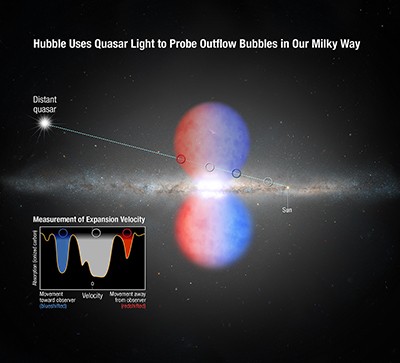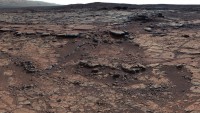Massive Quasar Storm in Milky Way Explodes at 2 Million Miles an Hour
| Ana Verayo | | Jan 09, 2015 05:33 PM EST |
(Photo : NASA, ESA, and A. Feild (STScI)) This graphic shows how NASA's Hubble Space Telescope probed the light from a distant quasar to analyze the so-called Fermi Bubbles, two lobes of material being blown out of the core of our Milky Way galaxy.
A massive galactic explosion from the center of Milky Way that produced Fermi Bubbles has been detected by the Hubble Space Telescope's Cosmic Origins Spectrograph (COS).
This bubbles were apparently formed by a 3 million kilometers-per-hour outburst from the center of the Milky Way about 2.5 to 4 million years ago. Today, the effects can still be felt via a couple of 30,000 light year old gas clouds as this colossal eruption spewed gas in two plumes at speeds of 2 million miles per hour.
Like Us on Facebook
Scientists have only recently discovered these structures about five years ago using data from NASA's Fermi Gamma-Ray Space Telescope. Since then, these gas clouds were observed and monitored by the team, and they have obtained its measurements and composition along with the velocity of the lobes.
These bubbles form a figure eight shape in the center of the Milky Way galaxy where astronomers used the light from a quasar which is a distant celestial object in order to monitor the Fermi Bubbles. These bubbles are also not visible to the human eye as they only emit X-rays, radio waves or gamma waves, all of which are invisible.
According to Andrew Fox, lead researcher of the study from the Space Telescope Science Institute in Baltimore, other galaxies also possess this similar outflow of gases and other cosmic materials.
Data collected from the COS instrument indicate the composition of the material that made up the gas clouds of carbon, aluminum and silicon particles. This means that the gas is rich in the basic elements used to produce a star, or it could also be fragments from a star formation.
This marks the first study that surveyed 20 quasars where their light passes through these Fermi Bubbles in the center of the Milky Way galaxy.
Tagshubble telescope, NASA, fermi bubbles, milky way galaxy, milky way fermi bubbles storm, Milky Way Galaxy's Center Has Mysterious Colossal Storm at 2 Million Miles An Hour, Milky Way Has a Massive Quasar Storm at 2 Million Miles An Hour
©2015 Chinatopix All rights reserved. Do not reproduce without permission
EDITOR'S PICKS
-

Did the Trump administration just announce plans for a trade war with ‘hostile’ China and Russia?
-

US Senate passes Taiwan travel bill slammed by China
-

As Yan Sihong’s family grieves, here are other Chinese students who went missing abroad. Some have never been found
-

Beijing blasts Western critics who ‘smear China’ with the term sharp power
-

China Envoy Seeks to Defuse Tensions With U.S. as a Trade War Brews
-

Singapore's Deputy PM Provides Bitcoin Vote of Confidence Amid China's Blanket Bans
-

China warns investors over risks in overseas virtual currency trading
-

Chinese government most trustworthy: survey
-

Kashima Antlers On Course For Back-To-Back Titles
MOST POPULAR
LATEST NEWS
Zhou Yongkang: China's Former Security Chief Sentenced to Life in Prison

China's former Chief of the Ministry of Public Security, Zhou Yongkang, has been given a life sentence after he was found guilty of abusing his office, bribery and deliberately ... Full Article
TRENDING STORY

China Pork Prices Expected to Stabilize As The Supplies Recover

Elephone P9000 Smartphone is now on Sale on Amazon India

There's a Big Chance Cliffhangers Won't Still Be Resolved When Grey's Anatomy Season 13 Returns

Supreme Court Ruled on Samsung vs Apple Dispute for Patent Infringement

Microsoft Surface Pro 5 Rumors and Release Date: What is the Latest?













